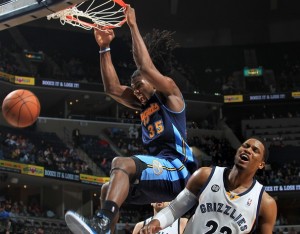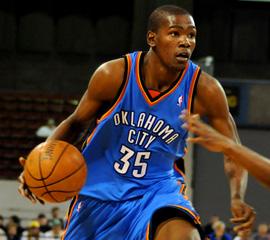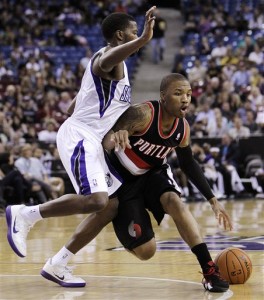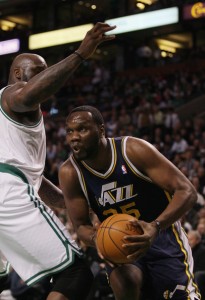- Attacking style not the only reason some Tottenham fans will back Ange Postecoglou until the bitter endPosted 5 months ago
- Paris Olympics takeaways: What did Team USA’s crunch-time lineup say about NBA’s hierarchy?Posted 10 months ago
- Zach Edey posted an easy double-double in Summer League debut. Here’s why he’ll succeed in NBAPosted 12 months ago
- What will we most remember these champion Boston Celtics for?Posted 12 months ago
- After long, seven-year road filled with excruciating losses, Celtics’ coast to NBA title felt ‘surreal’Posted 1 year ago
- South Florida men’s basketball is on an unbelievable heater– but also still on the bubblePosted 1 year ago
- Kobe Bufkin is balling out for Atlanta Hawks’ G League team. When will he be called up to NBA?Posted 1 year ago
- Former Knicks guards Immanuel Quickley, RJ Barrett may yet prove Raptors won the OG Anunoby tradePosted 1 year ago
- Rebounding savant Oscar Tshiebwe finally gets NBA chance he’s deserved for yearsPosted 2 years ago
- Is Tyrese Maxey vs. Tyrese Haliburton the next great NBA guard rivalry?Posted 2 years ago
Inside the Numbers: NBA Northwest Division
- Updated: November 29, 2012
By: Kevin LaFrancis
A classic line from Alfred Hitchcock’s fittingly titled movie North by Northwest featured an infamous villain named Phillip Vandamm sitting down and saying to Roger Thornhill, “Games? Must we?” He wanted to cut to the chase. Often times, regular season NBA drags on with a predetermined finale. We want the season to jump to the “chase,” the variability of playoff basketball. For most divisions, we already know who will rise to the top months before 82 games are played. However, this division is bringing the excitement back. Just like the Atlantic division, all five teams in the Northwest have a legitimate chance to make the playoffs. Once Durant’s franchise is penciled in at the top, the last four teams could finish in any of the four other positions. The drama of each game in this division will keep us glued to the present. Here’s my take on the Northwest.
Denver is starting the season by streaking more than the frat members of “Old School”. The Nuggets began the season with three straight losses, then won four consecutive games, lost three straight again, and rode another four game win streak before their most recent loss. George Karl’s squads always contend because they do not need superstars to succeed. Andre Iguodala, the most talented Denver player, is a mismatch guard (15.6 ppg, 6.3 rpg) that physically wears down his opponents. As the acting “captain,” Iguodala leads more often than Tiger on Sunday. His commanding voice can be heard from the nosebleeds as the Nuggets communicate better than any other team in the Western Conference.
Iguodala’s imposing presence draws the respect of the team’s younger players, especially fellow starters Kenneth Fareid, Ty Lawson, and Danilo Gallinari. Fareid, the all-time leading rebounder in Division 1 college history, has grabbed double-doubles in six of his last eight games. Fareid uses his body on his post moves so well that it is nearly impossible to stop him without fouling. At the point, Lawson’s wide body and 5’11’’ frame make him a hybrid for his position. He is quick and strong, averaging 13.1 points and 7.4 assists per game. He can blow by defenders off the dribble and use his body to disrupt other guards. Gallinari, a forward from Italy, gives the Nuggets similar numbers to Iguodala (15.4 ppg, 6.2 rpg). His feet move slower than holiday traffic but he is otherwise a fundamentally sound defender. Right now, the Nuggets offensive and defensive statistics rank in the middle of the league. I believe that Denver will eventually grind out many more wins than losses because it has a great coach and team leader that know how to close games.
*Before Season Grade: B
*Current Grade: B-
End of Regular Season Projection: 2nd in Division, 6th in Conference
![]() Minnesota Timberwolves (Record: 5-7)
Minnesota Timberwolves (Record: 5-7)
The Target Center is Cupid’s bulls eye. Love is in the air. After being out the first nine games with a hand injury, Kevin Love is finally back in the Timberwolves lineup. The team needs him. Following embarrassing losses at the hands of Toronto and Charlotte, Minnesota is desperate for an offensive boost. The Wolves severely missed the big man’s scoring inside. The team is 28th in the league, putting up only 91.7 points per game. All the analysts and fans who think Dwight Howard is a better player can take him. Kevin Love is the ideal center in today’s game. He can score a variety of ways in the paint. As a secondary option, he can score on jump shots. He rebounds the basketball better than anyone in the league. He finds the open man out of double teams. He does not foul. He runs the floor. And he grows a full beard (unlike the Gasol brothers). What’s not to Love?
Minnesota has won the majority of its games at home against weak opponents. The defense has held up. Andrei Kirilenko and Derrick Williams are two players on the roster who have shut their opponents down. Kirilenko (12.9 ppg, 7.9 rpg) will likely become even more effective with Love back on the roster. Although Kirilenko’s role will probably expand, Williams’ playing time will decrease. This may not be such a bad thing. With reduced minutes, Williams can wear himself out and play at a higher intensity. Minnesota’s bench is one of the best in the league. Jose Juan Barea and Alexey Shved, a rookie from Russia, give the T-Wolves good minutes at the point. Chase Budinger shoots the basketball well at the small forward position. Josh Howard is a trustworthy veteran. Minnesota has a decent chance of making the playoffs, but expecting them to go anywhere this postseason is a stretch.
*Before Season Grade: B
*Current Grade: C
End of Regular Season Projection: 3rd in Division, 7th in Conference
![]()
Memories of last year’s championship series and LeBron’s ensuing displays of gratification fill Kevin Durant with anger, desire, and the need for revenge. He channels all of these emotions into executing on the floor. Durant is the most dangerous player in the league right now. It’s almost frightening to watch him methodically and robotically torment his competition with no emotion. His averages are otherworldly (26.5 ppg, 9.4 rpg, 4.5 apg), but he never boasts. It’s a refreshing change from the typical NBA gloat. He plays respectable defense in addition to torturing teams on the other end. He leads silently and is a perfect complement to his enthusiastic teammate Russell Westbrook. Westbrook (21.8 ppg, 8.4 apg, 4.7 rpg) is another triple threat player that demonstrates his athleticism every game. In seemingly every contest, the point guard makes a couple plays or extends a few possessions that no other player in the game can do.
Kevin Martin, the Thunder’s best shooting guard, comes off the bench and puts up 15.9 points per game. Oklahoma City also has the NBA leader in blocks, Serge Ibaka (3.07 per game). Ibaka has more rejections than a pile of reviewed Ivy League applications. He also provides offense and rebounding for a team already loaded with scorers and rebounders (15.1 ppg, 7.6 rpg). Other Thunder players know and execute their respective roles. Kendrick Perkins enforces. Thabo Sefolosha shoots jumpers. Hasheem Thabeet rebounds. Two major problems will ultimately keep the Thunder from winning the championship. First, they do not move the ball well. In closing stretches of games, they are constantly shooting contested jumpers instead of getting open looks. Second, they turn the ball over too much. They are 3rd worst in the league in turnovers committed.
*Before Season Grade: A-
*Current Grade: B+
End of Regular Season Projection: 1st in Division, 2nd in Conference
![]() Portland Trail Blazers (Record: 6-8)
Portland Trail Blazers (Record: 6-8)
The play out of Portland’s backups this year has been nothing short of embarrassing. The Blazers rank last in the league in average bench points (12.2). The Lakers are the only team that does not average twice as many bench points as the Blazers. However, the Portland starters keep the team playing .500 basketball. Portland’s dynamic frontcourt is one of the best in the game. Forward Lamarcus Aldridge (19.7 ppg, 7.3 rpg) has struggled to finish inside this year, shooting just 44% from the field. Despite his struggles, he still is among the most successful forwards. Accompanying Aldridge in the paint is center J.J. Hickson. Hickson has averaged a double-double (11.3 ppg, 10.8 rpg) this year. His physical presence is imposing. He’s as ripped as wrapping paper on Christmas and runs the floor like a gazelle. He rarely forces bad shots, converting on 52.3% of his field goal attempts. In the backcourt, Portland has Damien Lilliard and Wesley Matthews, two solid guards.
Lilliard runs the point and does a great job pushing the basketball. Portland beats teams when they get out in transition, and Lilliard facilitates up-tempo basketball. He keeps his turnovers down despite speeding the game up. He pays attention to the details. Comparable to a young Jason Kidd, Lilliard works on passing to shooters’ hands while running down the court. Hitting shooters in the hands allows them to release their shots quickly and in rhythm. Matthews and the Blazers 5th starter, Nicolas Batum, benefit from this the most. Matthews, averaging 17.5 points per game, scores most of his points off open jump shots. Batum is more of a dual threat, attacking the basket as well as taking jumpers. As the season progresses, I think that the Blazers will lose several games in the fourth quarter because opponents will be less tired. I do not believe the team’s final record will be good enough to make the postseason.
*Before Season Grade: C+
*Current Grade: C-
End of Regular Season Projection: 5th in Division, 10th in Conference
![]() Utah Jazz (Record: 8-7)
Utah Jazz (Record: 8-7)
Al Jefferson (15.6 ppg, 11.2 rpg) has reached his prime. Seven seasons into his career, Jefferson has evolved from a big man with limited skills into Utah’s number one option. He recently injured his left ankle against Sacramento, a problem that may hamper his effectiveness temporarily. Playing next to Jefferson in the frontcourt is power forward Paul Millsap. Millsap’s lower body strength propels him to rebounds and loose balls. He hustles hard for someone his size and competes hard every possession. Utah often puts three big men on the floor at the same time. Marvin Williams and Derrick Favors both play over 24 minutes per contest. Williams can extend his game outside the paint whereas Favors is more of an interior forward that rebounds better. Defensively, Utah’s strategy is to contain the opposition.
Utah’s main problem is a specific part of its system. The Jazz are the worst team in the division at forcing turnovers, causing only 13.4 per game. The half court defense is average, but the team rarely gets “live ball” opportunities. “Live ball” turnovers include steals and blocks that lead to a change of possession. These types of turnovers lead to easy baskets in transition because the defense does not have time to react or recover. Over the course of an entire game, Utah scores almost all of its points in the half court while opponents score more in transition. Utah’s quest for a playoff berth will be riveting. One game could make the difference between going home and staying alive. I will have my eyes glued to this team throughout the year, tracking its progress.
*Before Season Grade: C+
*Current Grade: B-
End of Regular Season Projection: 4th in Division, 9th in Conference
 :






Pingback: Inside the Numbers: NBA Northwest Division | JockSpin.com Sports News and Opinion Aggregator and Publisher